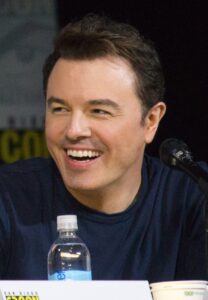At first glance, cartoons might seem like the last place you’d expect to find cannabis culture. Animated shows are traditionally built for kids, full of bright colors and moral lessons. But sometime in the late 1990s and early 2000s, something shifted. Cartoons grew up, the audience changed, and the jokes got a lot greener
Weed humor is now baked into adult animation. From The Simpsons to Rick and Morty, South Park to Family Guy, and even children’s adjacent programming like Adventure Time, subtle and not-so-subtle cannabis references have become a core part of the genre. Some of it is clever. Some of it is loud. But all of it is telling
Why are cartoons so obsessed with weed jokes? And what does this say about our culture?
Animation Grew Up With the Audience
One of the simplest explanations for cannabis humor in cartoons is that the cartoons themselves stopped being for kids. The rise of adult animation in the 1990s was a direct response to an audience that wanted satire, politics, and edgier content packaged in a visually engaging format
Shows like The Simpsons began pushing boundaries with jokes that adults appreciated more than children. When Homer got high with Tommy Chong in a 2003 episode titled “Weekend at Burnsie’s,” it wasn’t just a gag. It was a cultural milestone. Fox aired a primetime cartoon openly depicting marijuana use. Homer’s experience getting a medical card, feeling euphoric, then paranoid, and eventually losing interest was played for laughs, but it also mirrored real debates about cannabis use at the time
From there, it only snowballed. Adult animation took off. Futurama, King of the Hill, American Dad, and Family Guy all followed suit with their own spins on weed jokes. Sometimes it was a quick line. Other times it was an entire episode. Either way, cannabis became a recurring cast member
Weed as a Shortcut to Rebellion
Cartoons have always used exaggerated visuals and absurd plots to critique society. Weed jokes became a kind of shorthand for rebellion, freedom, and nonconformity. When a character lights up, it signals they are not following the rules. In animation, that can mean anything from ignoring authority to transcending time and space
Consider Rick and Morty. The show doesn’t explicitly depict marijuana use very often, but the entire vibe of the series feels rooted in stoner logic. A genius scientist with no filter and a drinking problem dragging his anxious grandson through parallel universes? That’s cannabis-coded storytelling at its core
Even when weed is not the main focus, it is part of the show’s DNA. Many of Rick and Morty’s fans watch while high, and the creators know it. Episodes are packed with complex visuals, existential jokes, and psychedelic sequences that appeal to a baked brain. Weed is not always shown on-screen, but it is assumed in the atmosphere
The Cultural Shift That Made It Possible
The rise of cannabis jokes in animation also tracks with the broader shift in cannabis legalization and normalization. In the early 2000s, states like California began to loosen their laws. Suddenly, the idea of smoking weed wasn’t just rebellious. It was relatable
Writers could make jokes about dispensaries, strains, and side effects without losing the audience. People understood the references. Weed wasn’t taboo anymore. It was common, even if still technically illegal in some places. That cultural familiarity gave animators more freedom to play with cannabis without controversy
It also helped that the internet allowed for niche content to flourish. Adult Swim built an empire on shows that would have never survived network TV ten years earlier. Aqua Teen Hunger Force, The Boondocks, and Metalocalypse all pushed boundaries, including cannabis humor, with minimal censorship
The Stoner Archetype Becomes a Trope
As cannabis humor grew more common, the stoner character became a reliable trope in animation. These characters are not always central to the plot, but they carry the same traits. They are laid-back, often confused, slow to act but quick with a one-liner
Think of Shaggy from Scooby-Doo, who was never confirmed to be a stoner, but the clues are all there. He talks to his dog, is always hungry, and avoids confrontation. Later shows leaned into this interpretation
Then there’s Towelie from South Park, a literal talking towel created to parody useless side characters who love to get high. His catchphrase? “Don’t forget to bring a towel” followed by “Wanna get high?” The joke worked because audiences were already familiar with the idea of a stoner character, and South Park turned it into absurdist satire
The stoner archetype became a flexible tool. Writers could use it to make fun of lazy characters, to critique society, or to simply insert a moment of comic relief
Visual Comedy Meets Psychedelia
Animation allows for wild visuals that live action cannot match. That makes it perfect for depicting the exaggerated effects of cannabis
When a character in a cartoon smokes weed, the animators often use swirling backgrounds, color warping, floating objects, and time loops to simulate the high. These sequences are visually interesting and often very funny, especially for viewers who know the feeling
In Regular Show, a series aimed at older teens, many episodes involve trippy battles, magical items, and surreal humor that feels influenced by cannabis culture. It’s not always explicit, but the tone invites interpretation. Adults watching with their own cannabis experiences can easily read between the lines
These visual gags resonate because they’re creative. They capture something that’s hard to describe with words alone. The dazed expression, the echoing laughter, the sense of floating—it’s all there on screen
Real-Life Cannabis Creators
Behind many of these shows are writers and animators who openly use cannabis. They are not just writing jokes about weed. They are writing from experience
Seth MacFarlane, Justin Roiland, and Mike Judge have all incorporated cannabis into their work in both subtle and obvious ways. They grew up in an era where weed was becoming part of the comedy playbook. Now they are the ones defining it
Seth Rogen, a major figure in both film and cannabis, has voiced characters in animated shows and created entire stoner comedies that bridge the gap between live-action and cartoons. His influence on how cannabis is portrayed in comedy cannot be overstated
These creators understand that weed is not just a punchline. It is a cultural lens. A way to explore everything from anxiety and boredom to creativity and existential dread.

From Laugh Track to Lifestyle
Cannabis jokes in cartoons have shifted from one-liners to lifestyle storytelling. Instead of mocking stoners, shows now explore cannabis as part of a broader personality. It is not the joke. It is the context
In recent years, shows like Big Mouth and Disenchantment have tackled cannabis use with more nuance. Characters explore weed for anxiety, trauma, or connection. The humor is still there, but the tone is different. It feels more mature, more aware
This mirrors how audiences now see cannabis. It is not just something you do for fun. It is part of how you unwind, reflect, or even treat yourself. Cartoons reflect this maturity by showing a wider range of experiences with cannabis
Cartoons as a Safe Space for Subversion
Animation offers a layer of detachment that makes controversial topics easier to address. You can show a cartoon character doing something risky, and it feels less threatening than watching a real person do it
This is why cannabis jokes can fly under the radar in animation. The medium allows creators to be bold without triggering the same level of backlash. It’s all “just a cartoon,” even when the message is very real
That’s a big reason weed has thrived in this space. It allows audiences to laugh, question, and reflect all without breaking the fourth wall
How It Shows Up Today
Look at any modern animated show and you’ll still find cannabis references. They are not always overt, but they are frequent
In BoJack Horseman, the characters struggle with addiction, identity, and fame. Cannabis use is shown alongside these deeper themes, not as a solution but as part of the complexity
In Solar Opposites, an alien sitcom from one of the creators of Rick and Morty, weed jokes show up in nearly every episode, often in the form of misunderstanding human behavior
Even The Simpsons still includes weed references, decades after that infamous Tommy Chong episode. The show evolved with its audience, and weed jokes evolved with it
Final Thoughts: Why It Matters
Cannabis jokes in cartoons are not just funny. They are cultural markers. They tell us how far we’ve come in normalizing cannabis, and how comedy has been a major part of that process
Here at Token Dispensary in Rego Park, Queens, we see that cultural shift every day. Our customers are informed, creative, and curious. They’ve seen the jokes. They know the references. And they’re ready to experience the real thing.



